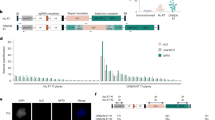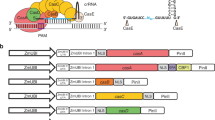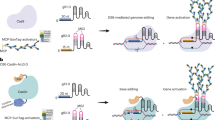Abstract
The construction of synthetic gene circuits in plants has been limited by a lack of orthogonal and modular parts. Here, we implement a CRISPR (clustered regularly interspaced short palindromic repeats) interference (CRISPRi)-based reversible gene circuit platform in plants. We create a toolkit of engineered repressible promoters of different strengths and construct NOT and NOR gates in Arabidopsis thaliana protoplasts. We determine the optimal processing system to express single guide RNAs from RNA Pol II promoters to introduce NOR gate programmability for interfacing with host regulatory sequences. The performance of a NOR gate in stably transformed Arabidopsis plants demonstrates the system’s programmability and reversibility in a complex multicellular organism. Furthermore, cross-species activity of CRISPRi-based logic gates is shown in Physcomitrium patens, Triticum aestivum and Brassica napus protoplasts. Layering multiple NOR gates together creates OR, NIMPLY and AND logic functions, highlighting the modularity of our system. Our CRISPRi circuits are orthogonal, compact, reversible, programmable and modular and provide a platform for sophisticated spatiotemporal control of gene expression in plants.
This is a preview of subscription content, access via your institution
Access options
Access Nature and 54 other Nature Portfolio journals
Get Nature+, our best-value online-access subscription
$29.99 / 30 days
cancel any time
Subscribe to this journal
Receive 12 print issues and online access
$209.00 per year
only $17.42 per issue
Buy this article
- Purchase on Springer Link
- Instant access to full article PDF
Prices may be subject to local taxes which are calculated during checkout






Similar content being viewed by others
Data availability
All the data analyzed and used for generating figures in this study are provided in Supplementary Tables 5 and 8. The plasmids generated in this study will be made available through Addgene. DNA sequences are available in a Zenodo repository79 (https://doi.org/10.5281/zenodo.10528436).
References
Thompson, A. J. et al. Ectopic expression of a tomato 9-cis-epoxycarotenoid dioxygenase gene causes over-production of abscisic acid. Plant J. 23, 363–374 (2000).
Iuchi, S. et al. Regulation of drought tolerance by gene manipulation of 9-cis-epoxycarotenoid dioxygenase, a key enzyme in abscisic acid biosynthesis in Arabidopsis. Plant J. 27, 325–333 (2001).
Feeney, M., Frigerio, L., Cui, Y. & Menassa, R. Following vegetative to embryonic cellular changes in leaves of Arabidopsis overexpressing LEAFY COTYLEDON2. Plant Physiol. 162, 1881–1896 (2013).
Vanhercke, T. et al. Step changes in leaf oil accumulation via iterative metabolic engineering. Metab. Eng. 39, 237–246 (2017).
He, R. et al. Overexpression of 9-cis-epoxycarotenoid dioxygenase cisgene in grapevine increases drought tolerance and results in pleiotropic effects. Front. Plant Sci. 9, 970 (2018).
Hancock, J. F. A framework for assessing the risk of transgenic crops. Bioscience 53, 512–519 (2003).
Jaglo, K. R. et al. Components of the Arabidopsis C-repeat/dehydration-responsive element binding factor cold-response pathway are conserved in Brassica napus and other plant species. Plant Physiol. 127, 910–917 (2001).
Brophy, J. A. N. & Voigt, C. A. Principles of genetic circuit design. Nat. Methods 11, 508–520 (2014).
Kassaw, T. K., Donayre-Torres, A. J., Antunes, M. S., Morey, K. J. & Medford, J. I. Engineering synthetic regulatory circuits in plants. Plant Sci. 273, 13–22 (2018).
Andres, J., Blomeier, T. & Zurbriggen, M. D. Synthetic switches and regulatory circuits in plants. Plant Physiol. 179, 862–884 (2019).
de Lange, O., Klavins, E. & Nemhauser, J. Synthetic genetic circuits in crop plants. Curr. Opin. Biotechnol. 49, 16–22 (2018).
Xia, P.-F., Ling, H., Foo, J. L. & Chang, M. W. Synthetic genetic circuits for programmable biological functionalities. Biotechnol. Adv. 37, 107393 (2019).
Verbič, A., Praznik, A. & Jerala, R. A guide to the design of synthetic gene networks in mammalian cells. FEBS J. 288, 5265–5288 (2021).
Chen, Y. et al. Genetic circuit design automation for yeast. Nat. Microbiol. 5, 1349–1360 (2020).
Weber, W. & Fussenegger, M. Engineering of synthetic mammalian gene networks. Chem. Biol. 16, 287–297 (2009).
Lienert, F., Lohmueller, J. J., Garg, A. & Silver, P. A. Synthetic biology in mammalian cells: next generation research tools and therapeutics. Nat. Rev. Mol. Cell Biol. 15, 95–107 (2014).
Mahfouz, M. M. et al. Targeted transcriptional repression using a chimeric TALE–SRDX repressor protein. Plant Mol. Biol. 78, 311–321 (2012).
Lowder, L. G., Paul, J. W. 3rd & Qi, Y. Multiplexed transcriptional activation or repression in plants using CRISPR–dCas9-based systems. Methods Mol. Biol. 1629, 167–184 (2017).
Hiratsu, K., Matsui, K., Koyama, T. & Ohme-Takagi, M. Dominant repression of target genes by chimeric repressors that include the EAR motif, a repression domain, in Arabidopsis. Plant J. 34, 733–739 (2003).
Leydon, A. R. et al. Repression by the Arabidopsis TOPLESS corepressor requires association with the core mediator complex. eLife 10, e66739 (2021).
Leydon, A. R., Ramos Báez, R. & Nemhauser, J. L. A single helix repression domain is functional across diverse eukaryotes. Proc. Natl Acad. Sci. USA 119, e2206986119 (2022).
Vazquez-Vilar, M. et al. GB3.0: a platform for plant bio-design that connects functional DNA elements with associated biological data. Nucleic Acids Res. 45, 2196–2209 (2017).
Schaumberg, K. A. et al. Quantitative characterization of genetic parts and circuits for plant synthetic biology. Nat. Methods 13, 94 (2015).
Brophy, J. A. N. et al. Synthetic genetic circuits as a means of reprogramming plant roots. Science 377, 747–751 (2022).
Belcher, M. S. et al. Design of orthogonal regulatory systems for modulating gene expression in plants. Nat. Chem. Biol. 16, 857–865 (2020).
Bernabé-Orts, J. M. et al. A memory switch for plant synthetic biology based on the phage ϕC31 integration system. Nucleic Acids Res. 48, 3379–3394 (2020).
Lloyd, J. P. B. et al. Synthetic memory circuits for stable cell reprogramming in plants. Nat. Biotechnol. 40, 1862–1872 (2022).
Guiziou, S., Maranas, C. J., Chu, J. C. & Nemhauser, J. L. An integrase toolbox to record gene-expression during plant development. Nat. Commun. 14, 1844 (2023).
Qi, L. S. et al. Repurposing CRISPR as an RNA-guided platform for sequence-specific control of gene expression. Cell 152, 1173–1183 (2013).
Gander, M. W., Vrana, J. D., Voje, W. E., Carothers, J. M. & Klavins, E. Digital logic circuits in yeast with CRISPR–dCas9 NOR gates. Nat. Commun. 8, 15459 (2017).
Kiani, S. et al. CRISPR transcriptional repression devices and layered circuits in mammalian cells. Nat. Methods 11, 723–726 (2014).
Yeo, N. C. et al. An enhanced CRISPR repressor for targeted mammalian gene regulation. Nat. Methods 15, 611–616 (2018).
Nielsen, A. A. K. & Voigt, C. A. Multi-input CRISPR/Cas genetic circuits that interface host regulatory networks. Mol. Syst. Biol. 10, 763 (2014).
Santos-Moreno, J., Tasiudi, E., Stelling, J. & Schaerli, Y. Multistable and dynamic CRISPRi-based synthetic circuits. Nat. Commun. 11, 2746 (2020).
Kim, H., Bojar, D. & Fussenegger, M. A CRISPR/Cas9-based central processing unit to program complex logic computation in human cells. Proc. Natl Acad. Sci. USA 116, 7214–7219 (2019).
Jones, D. L. et al. Kinetics of dCas9 target search in Escherichia coli. Science 357, 1420–1424 (2017).
Martens, K. J. A. et al. Visualisation of dCas9 target search in vivo using an open-microscopy framework. Nat. Commun. 10, 3552 (2019).
Santos-Moreno, J. & Schaerli, Y. CRISPR-based gene expression control for synthetic gene circuits. Biochem. Soc. Trans. 48, 1979–1993 (2020).
Lowder, L. G. et al. A CRISPR/Cas9 toolbox for multiplexed plant genome editing and transcriptional regulation. Plant Physiol. 169, 971–985 (2015).
Piatek, A. et al. RNA-guided transcriptional regulation in planta via synthetic dCas9-based transcription factors. Plant Biotechnol. J. 13, 578–589 (2015).
Vazquez-Vilar, M. et al. A modular toolbox for gRNA–Cas9 genome engineering in plants based on the GoldenBraid standard. Plant Methods 12, 10 (2016).
Vazquez-Vilar, M. et al. The GB4.0 platform, an all-in-one tool for CRISPR/Cas-based multiplex genome engineering in plants. Front. Plant Sci. 12, 689937 (2021).
Khakhar, A., Leydon, A. R., Lemmex, A. C., Klavins, E. & Nemhauser, J. L. Synthetic hormone-responsive transcription factors can monitor and re-program plant development. eLife 7, e34702 (2018).
Han, Y.-J., Kim, Y.-M., Hwang, O.-J. & Kim, J.-I. Characterization of a small constitutive promoter from Arabidopsis translationally controlled tumor protein (AtTCTP) gene for plant transformation. Plant Cell Rep. 34, 265–275 (2015).
Somssich, M. A short history of the CaMV 35S promoter. Preprint at PeerJ https://doi.org/10.7287/peerj.preprints.27096v3 (2019).
Yilmaz, A. et al. AGRIS: the Arabidopsis Gene Regulatory Information Server, an update. Nucleic Acids Res. 39, D1118–D1122 (2011).
Davuluri, R. V. et al. AGRIS: Arabidopsis gene regulatory information server, an information resource of Arabidopsis cis-regulatory elements and transcription factors. BMC Bioinformatics 4, 25 (2003).
Palaniswamy, S. K. et al. AGRIS and AtRegNet. A platform to link cis-regulatory elements and transcription factors into regulatory networks. Plant Physiol. 140, 818–829 (2006).
Vancanneyt, G., Schmidt, R., O’Connor-Sanchez, A., Willmitzer, L. & Rocha-Sosa, M. Construction of an intron-containing marker gene: splicing of the intron in transgenic plants and its use in monitoring early events in Agrobacterium-mediated plant transformation. Mol. Gen. Genet. 220, 245–250 (1990).
Gao, Y. & Zhao, Y. Self-processing of ribozyme-flanked RNAs into guide RNAs in vitro and in vivo for CRISPR-mediated genome editing. J. Integr. Plant Biol. 56, 343–349 (2014).
Cermak, T. et al. A multi-purpose toolkit to enable advanced genome engineering in plants. Plant Cell 29, 1196–1217 (2017).
Xie, K., Minkenberg, B. & Yang, Y. Boosting CRISPR/Cas9 multiplex editing capability with the endogenous tRNA-processing system. Proc. Natl Acad. Sci. USA 112, 3570–3575 (2015).
Haurwitz, R. E., Jinek, M., Wiedenheft, B., Zhou, K. & Doudna, J. A. Sequence- and structure-specific RNA processing by a CRISPR endonuclease. Science 329, 1355–1358 (2010).
Nissim, L., Perli, S. D., Fridkin, A., Perez-Pinera, P. & Lu, T. K. Multiplexed and programmable regulation of gene networks with an integrated RNA and CRISPR/Cas toolkit in human cells. Mol. Cell 54, 698–710 (2014).
Lodish, H., et al. Molecular Cell Biology (W. H. Freeman, 2000).
Schramm, L. & Hernandez, N. Recruitment of RNA polymerase III to its target promoters. Genes Dev. 16, 2593–2620 (2002).
Sherf, B. A., Navarro, S. L., Hannah, R. R. & Wood, K. V. Dual-luciferase TM reporter assay: an advanced co-reporter technology integrating firefly and Renilla luciferase assays. Promega Notes 57, 2–8 (1996).
McNabb, D. S., Reed, R. & Marciniak, R. A. Dual luciferase assay system for rapid assessment of gene expression in Saccharomyces cerevisiae. Eukaryot. Cell 4, 1539–1549 (2005).
Gilbert, L. A. et al. CRISPR-mediated modular RNA-guided regulation of transcription in eukaryotes. Cell 154, 442–451 (2013).
Gilbert, L. A. et al. Genome-scale CRISPR-mediated control of gene repression and activation. Cell 159, 647–661 (2014).
Thakore, P. I., Black, J. B., Hilton, I. B. & Gersbach, C. A. Editing the epigenome: technologies for programmable transcription and epigenetic modulation. Nat. Methods 13, 127–137 (2016).
Craft, J. et al. New pOp/LhG4 vectors for stringent glucocorticoid-dependent transgene expression in Arabidopsis. Plant J. 41, 899–918 (2005).
Takahashi, T., Naito, S. & Komeda, Y. The Arabidopsis HSP18.2 promoter/GUS gene fusion in transgenic Arabidopsis plants: a powerful tool for the isolation of regulatory mutants of the heat‐shock response. Plant J. 2, 751–761 (1992).
Horstmann, V., Huether, C. M., Jost, W., Reski, R. & Decker, E. L. Quantitative promoter analysis in Physcomitrella patens: a set of plant vectors activating gene expression within three orders of magnitude. BMC Biotechnol. 4, 13 (2004).
Gaber, R. et al. Designable DNA-binding domains enable construction of logic circuits in mammalian cells. Nat. Chem. Biol. 10, 203–208 (2014).
Leben, K. et al. Binding of the transcription activator-like effector augments transcriptional regulation by another transcription factor. Nucleic Acids Res. 50, 6562–6574 (2022).
Tompa, M. et al. Assessing computational tools for the discovery of transcription factor binding sites. Nat. Biotechnol. 23, 137–144 (2005).
Jiang, C. & Pugh, B. F. Nucleosome positioning and gene regulation: advances through genomics. Nat. Rev. Genet. 10, 161–172 (2009).
Heard, D. J., Kiss, T. & Filipowicz, W. Both Arabidopsis TATA binding protein (TBP) isoforms are functionally identical in RNA polymerase II and III transcription in plant cells: evidence for gene-specific changes in DNA binding specificity of TBP. EMBO J. 12, 3519–3528 (1993).
Mukumoto, F., Hirose, S., Imaseki, H. & Yamazaki, K. DNA sequence requirement of a TATA element-binding protein from Arabidopsis for transcription in vitro. Plant Mol. Biol. 23, 995–1003 (1993).
Gorochowski, T. E. et al. Genetic circuit characterization and debugging using RNA-seq. Mol. Syst. Biol. 13, 952 (2017).
Ohta, M., Matsui, K., Hiratsu, K., Shinshi, H. & Ohme-Takagi, M. Repression domains of class II ERF transcriptional repressors share an essential motif for active repression. Plant Cell 13, 1959–1968 (2001).
Kagale, S. & Rozwadowski, K. EAR motif-mediated transcriptional repression in plants: an underlying mechanism for epigenetic regulation of gene expression. Epigenetics 6, 141–146 (2011).
Yang, E. J. Y. & Nemhauser, J. L. Building a pipeline to identify and engineer constitutive and repressible promoters. Quant. Plant Biol. 4, e12 (2023).
Tas, H., Grozinger, L., Stoof, R., de Lorenzo, V. & Goñi-Moreno, Á. Contextual dependencies expand the re-usability of genetic inverters. Nat. Commun. 12, 355 (2021).
Gibson, D. G. et al. Enzymatic assembly of DNA molecules up to several hundred kilobases. Nat. Methods 6, 343–345 (2009).
Engler, C. et al. A Golden Gate modular cloning toolbox for plants. ACS Synth. Biol. 3, 839–843 (2014).
Pollak, B. et al. Universal loop assembly: open, efficient and cross-kingdom DNA fabrication. Synth. Biol. 5, ysaa001 (2020).
Khan, M. A. et al. CRISPRi-based circuits to control gene expression in plants. Zenodo https://doi.org/10.5281/zenodo.11108565 (2024).
Wick, R. R., Judd, L. M., Gorrie, C. L. & Holt, K. E. Unicycler: resolving bacterial genome assemblies from short and long sequencing reads. PLoS Comput. Biol. 13, e1005595 (2017).
Langmead, B. & Salzberg, S. L. Fast gapped-read alignment with Bowtie 2. Nat. Methods 9, 357–359 (2012).
Wu, F.-H. et al. Tape–Arabidopsis Sandwich—a simpler Arabidopsis protoplast isolation method. Plant Methods 5, 16 (2009).
Cove, D. J. et al. Isolation and regeneration of protoplasts of the moss Physcomitrella patens. Cold Spring Harb. Protoc. https://doi.org/10.1101/pdb.prot5140 (2009).
Cove, D. J. et al. Transformation of the moss Physcomitrella patens using direct DNA uptake by protoplasts. Cold Spring Harb. Protoc. https://doi.org/10.1101/pdb.prot5143 (2009).
Ganguly, D. R., Tyrrell, R. & Arndell, T. Protoplast isolation and PEG-mediated transformation. Protocols.io https://doi.org/10.17504/protocols.io.36wgqwd5gk57/v2 (2022).
Clough, S. J. & Bent, A. F. Floral dip: a simplified method for Agrobacterium-mediated transformation of Arabidopsis thaliana. Plant J. 16, 735–743 (1998).
Logemann, E., Birkenbihl, R. P., Ülker, B. & Somssich, I. E. An improved method for preparing Agrobacterium cells that simplifies the Arabidopsis transformation protocol. Plant Methods 2, 16 (2006).
Acknowledgements
The plasmid sequencing data were generated on instrumentation supported by the Australian Cancer Research Foundation Center for Advanced Cancer Genomics and Genomics WA. Seeds for the LhGR-N line were kindly provided by C. Helliwell. This work was supported by the following grants to R.L.: Australian Research Council (ARC) Center of Excellence (CoE) in plant energy biology (CE140100008), ARC CoE in plants for space (CE230100015), ARC DP210103954, NHMRC Investigator Grant GNT1178460, Silvia and Charles Viertel Senior Medical Research Fellowship and Howard Hughes Medical Institute International Research Scholarship. M.A.K. was supported by an International Postgraduate Research Scholarship. T.S. was supported by the Hackett Postgraduate Research Scholarship. B.K. was supported by the CSIRO Synthetic Biology Future Science Platform. D.S. was supported by an ARC Discovery Early Career Researcher Award (DE150100460).
Author information
Authors and Affiliations
Contributions
M.A.K., B.N.K. and R.L. conceptualized the study, designed the experiments and wrote the manuscript. M.A.K., with B.N.K., G.H., J.Y.Z., M.O., E.F., B.J., Z.Z., J.P., L.P. and J.P.B.L., conducted the experiments. M.A.K. designed the constructs and developed the 96-well protoplast transfection protocol. J.P., T.S. and C.P. conducted the plasmid sequencing. J.P.B.L, D.S. and I.S. provided assistance with the initial designs of constructs and designing experiments. All authors approved of and contributed to the final version of the manuscript.
Corresponding authors
Ethics declarations
Competing interests
The authors declare no competing interests.
Peer review
Peer review information
Nature Biotechnology thanks June Medford, Herve Vanderschuren and the other, anonymous, reviewer(s) for their contribution to the peer review of this work.
Additional information
Publisher’s note Springer Nature remains neutral with regard to jurisdictional claims in published maps and institutional affiliations.
Supplementary information
Supplementary Information
Supplementary Figs. 1–10 and Tables 1–4, 6 and 7.
Supplementary Table 5
Contains r.m.s.d. values.
Supplementary Table 8
Contains analyzed data used for generating figures.
Rights and permissions
Springer Nature or its licensor (e.g. a society or other partner) holds exclusive rights to this article under a publishing agreement with the author(s) or other rightsholder(s); author self-archiving of the accepted manuscript version of this article is solely governed by the terms of such publishing agreement and applicable law.
About this article
Cite this article
Khan, M.A., Herring, G., Zhu, J.Y. et al. CRISPRi-based circuits to control gene expression in plants. Nat Biotechnol (2024). https://doi.org/10.1038/s41587-024-02236-w
Received:
Accepted:
Published:
DOI: https://doi.org/10.1038/s41587-024-02236-w



